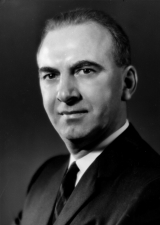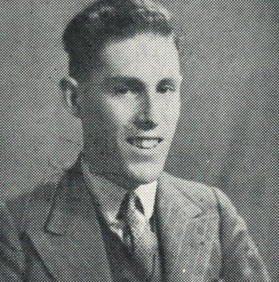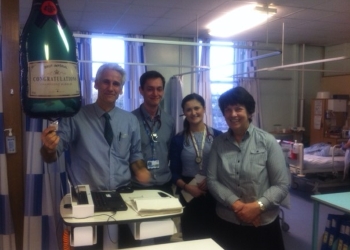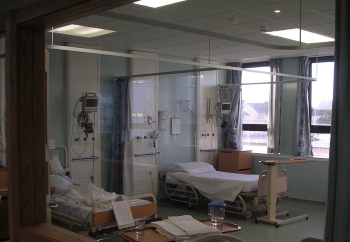Stroke
During the second half of the twentieth century, stroke became an increasing cause of death and disability in the ageing population. Increasing accuracy of diagnosis (brain scanning) together with randomised controlled trials of treatments (antithrombotics, thrombolytics, endovascular thrombectomy, preventative medication and supportive care) progressively improved the outcome of stroke. Stroke medicine specialists (within geriatric medicine, general medicine and neurology) developed stroke units and TIA clinics across Glasgow and the UK from the 1990s.
Stobhill Hospital - John Rankin and Early Stroke Services

Amongst Glasgow’s many achievements in the field of stroke care and research, one of the most notable is the creation of the first dedicated stroke unit. The early steps towards specialist stroke care began in the 1950s in the University Department of Materia Medica and Therapeutics, Stobhill Hospital.
In his first consultant post, Dr John Rankin was charged with the care of the ‘chronic sick beds’. These wards predominantly comprised patients with stroke and/or rheumatic heart disease, and until Rankin’s arrival had not been a research or clinical focus for Glasgow.
Rankin challenged the therapeutic nihilism that was prevalent at the time in stroke care. To appreciate the significance of Rankin’s ideas, it is worth remembering that up to that point stroke care had received little attention, with clinicians responding to complications as they arose but otherwise made few active interventions. Rankin proposed a paradigm that, while controversial at the time, is now recognised as the fundamental basis for stroke care. He created a geographically distinct cohort of patients with stroke and implemented early, active rehabilitation with a multidisciplinary team. In an attempt at goal setting, Rankin aimed to return these ‘long term’ patients home.
It is interesting that many decades later, when Professor Peter Langhorne and colleagues published their practice changing systematic review of stroke units (see below), these same elements seemed to be the core constituents of successful stroke centres.
The Rankin Scale
As well as his stroke unit work, Rankin also authored seminal work on neural plasticity and described new forms of occupational lung disease. However, despite all these achievements, Rankin is best remembered for a numerical scale that describes post stroke disability. To document the successes of his novel approach to stroke care, Rankin authored a series of papers in the Scottish Medical Journal.
As part of these reports, Rankin created an ordinal scale of potential stroke outcomes.
The scale ranged from Grade V ‘Severe disability, bedridden, incontinent and requiring constant nursing care and attention’ to (a then unthinkable outcome) of Grade I ‘No significant disability, able to carry out all usual duties’.
Decades later, the scale was modified slightly for use in the first multi-site stroke Randomised Controlled Trial, the UK Transient Ischaemic Attack (TIA) trial. The rediscovered modified Rankin Scale was then used in the first International Stroke Trial (IST), and subsequently has become the most commonly used outcome assessment tool in stroke research. Hopefully Rankin would approve of Glasgow’s continuing, practice changing research in stroke, much of which continues to use the scale that bears his name.
Royal Infirmary / Lightburn Hospital
B ernard Isaacs (1924-1995) was a “giant” of Geriatric Medicine. Indeed, it was he who coined the term “giants of Geriatric Medicine” to encompass the common syndromes encountered in the elderly population. He worked at Foresthall Home and Hospital (Springburn) before moving to Glasgow Royal Infirmary as a Physician in Geriatric Medicine in 1964. He became Professor of Geriatric Medicine in Birmingham University in 1975.
ernard Isaacs (1924-1995) was a “giant” of Geriatric Medicine. Indeed, it was he who coined the term “giants of Geriatric Medicine” to encompass the common syndromes encountered in the elderly population. He worked at Foresthall Home and Hospital (Springburn) before moving to Glasgow Royal Infirmary as a Physician in Geriatric Medicine in 1964. He became Professor of Geriatric Medicine in Birmingham University in 1975.
He established one of the first stroke units of its kind, a rehabilitation unit in Lightburn Hospital, which pioneered a multidisciplinary rehabilitation approach for people recovering after stroke. This unit remained in place for many years until the late 1980s. Ironically, it was closed for several years before further work and a meta-analysis coordinated by a Royal Infirmary team (Langhorne et al, Lancet 1993) confirmed the crucial role of multi-disciplinary stroke unit care in stroke management. The rehabilitation unit was duly re-opened in the 1990s.

A multidisciplinary stroke team, stroke clinic and an acute stroke unit also developed in the Royal Infirmary in the 1990s, led by Peter Langhorne (Senior Lecturer in Geriatric Medicine 1994, Professor of Stroke Care 2001), David Stott (Professor of Geriatric Medicine 1994) (more), and Drs Jennifer Burns and Jackie Taylor. Gordon Lowe (Senior Lecturer 1985, Professor of Vascular Medicine 1993) participated in clinical trials of nimodipine in acute stroke, and of antithrombotics in stroke prevention; and studied the role of thrombotic factors in stroke occurrence and outcome (see Department of Medicine, Royal Infirmary).
In recent years the stroke team was joined by Fiona Wright, Helen Slavin, Kate McArthur, Peter Higgins and Christine McAlpine (NHS consultants) and Terry Quinn (Senior Lecturer).
Western Infirmary
Staff at the Department of Medicine and Therapeutics set up an acute stroke unit in the Western Infirmary in May 1990, led by Professors Kennedy Lees (Professor of Cerebrovascular Medicine 1999); John Reid (Professor of Medicine and Therapeutics 1981-2010), Peter Semple, and Gordon McInnes (Professor of Clinical Pharmacology 2003) (see Medicine – Western Infirmary). They were later joined by Jesse Dawson, Matthew Walters, Scott Muir, Craig Harrow and Niall Hughes. This 6-bed unit quickly grew to 11 and then 14 beds. It had a major role in furthering acute stroke research, particularly in the areas of thrombolysis and neuroprotection, and in training of stroke specialists who have established corresponding services elsewhere in Glasgow as well as across Scotland and beyond. The unit moved to the new Queen Elizabeth University Hospital after closure of the Western Infirmary in 2015, merging with the South Glasgow service.
Modern stroke care now recognises that intervention within the first hours can dramatically alter the course of the disease. The Western Infirmary team pioneered the use of thrombolysis with a randomised trial of streptokinase in Glasgow from 1990, and leadership of the MAST Europe trial and the first individual patient data pooling project for thrombolysis that spawned the highly cited definitive summaries of thrombolysis use in stroke (read more Lancet 2010, 2014). Professor Lees established the Virtual International Stroke Trials Archive (VISTA). The acute unit was supported by a stroke rehabilitation service based in Drumchapel and Gartnavel hospitals, developed by Dr Jonathon MacDonald and subsequently staffed by Dr Niall Hughes and others.
Southern General Hospital and Queen Elizabeth University Hospital
At the Institute of Neurosciences, specialist interest in cerebrovascular medicine started in the 1980s with major participation in the European Carotid Surgery Trial (ECST). This led to the establishing of a regional service for young or “atypical” strokes and early imaging of physiological acute stroke changes (cerebrovascular reactivity) and extracranial/transcranial Doppler techniques.
The service was led by Professor Ian Bone and Mr David Mendelow (Senior Lecturer in Neurosurgery) and established one of the first UK TIA (transient ischaemic attack) clinics. Ian Bone and Professor Keith Muir (SINAPSE Chair of Clinical Imaging, stroke and brain imaging) with Dr Pamela Crawford (Consultant in Medicine for the Elderly) established a 4-bed acute unit from 2000 which focused on acute stroke research.

It centred around use of advanced brain and vascular imaging in translational clinical research, in collaboration with the department of Neuroradiology (Professor Donald Hadley, Dr Evelyn Teasdale, Professor Barrie Condon and other colleagues) (see Radiology). The unit contributed to a wide range of acute clinical trials and led trials on endovascular treatment and thrombolysis in acute stroke. The acute unit was supported by a stroke rehabilitation unit initially set up by Dr Susan Fraser.
In 2005 a comprehensive acute and rehabilitation service for South Glasgow was initiated, integrating the Regional service, Southern General and Victoria services. The stroke service amalgamated with the Western Infirmary stroke service at the Queen Elizabeth University Hospital site in 2015.
Stobhill Hospital
Dr Christine McAlpine joined Stobhill Hospital in 1997 to lead a redesign of its stroke service, including the opening of acute stroke beds. Dr Lindsay Erwin was initially part of the team and after his departure, Dr Pam Fraser was appointed. The service ran successfully until 2011 when all acute inpatient beds in Stobhill moved to Glasgow Royal Infirmary. At that time, all acute stroke beds were centralised in GRI, the stroke rehabilitation unit in Lightburn Hospital closed, and all inpatient stroke rehabilitation was centralised in the New Stobhill Hospital.
Victoria Infirmary
Drs Margaret Roberts and Iain Lennox established a 16-bedded stroke rehabilitation unit at the Mansionhouse, Victoria Infirmary in 1993. This rapidly expanded to 30 beds and with the appointment of Dr Jan Potter, a specialist service was provided to the acute receiving unit to support rapid transfer to rehabilitation services. The service merged with the Southern General in 2005 and finally closed in 2015.
By the early 2000’s, all the large Glasgow acute hospitals had stroke units and were carrying out stroke research (see more) in stroke imaging (Southern General Hospital), acute stroke therapies (Western Infirmary, Southern General Hospital), and stroke rehabilitation and complications ( Royal Infirmary).
Terry Quinn, Peter Langhorne, Kennedy Lees, Keith Muir, Christine McAlpine and Margaret Roberts
Images provided by authors

